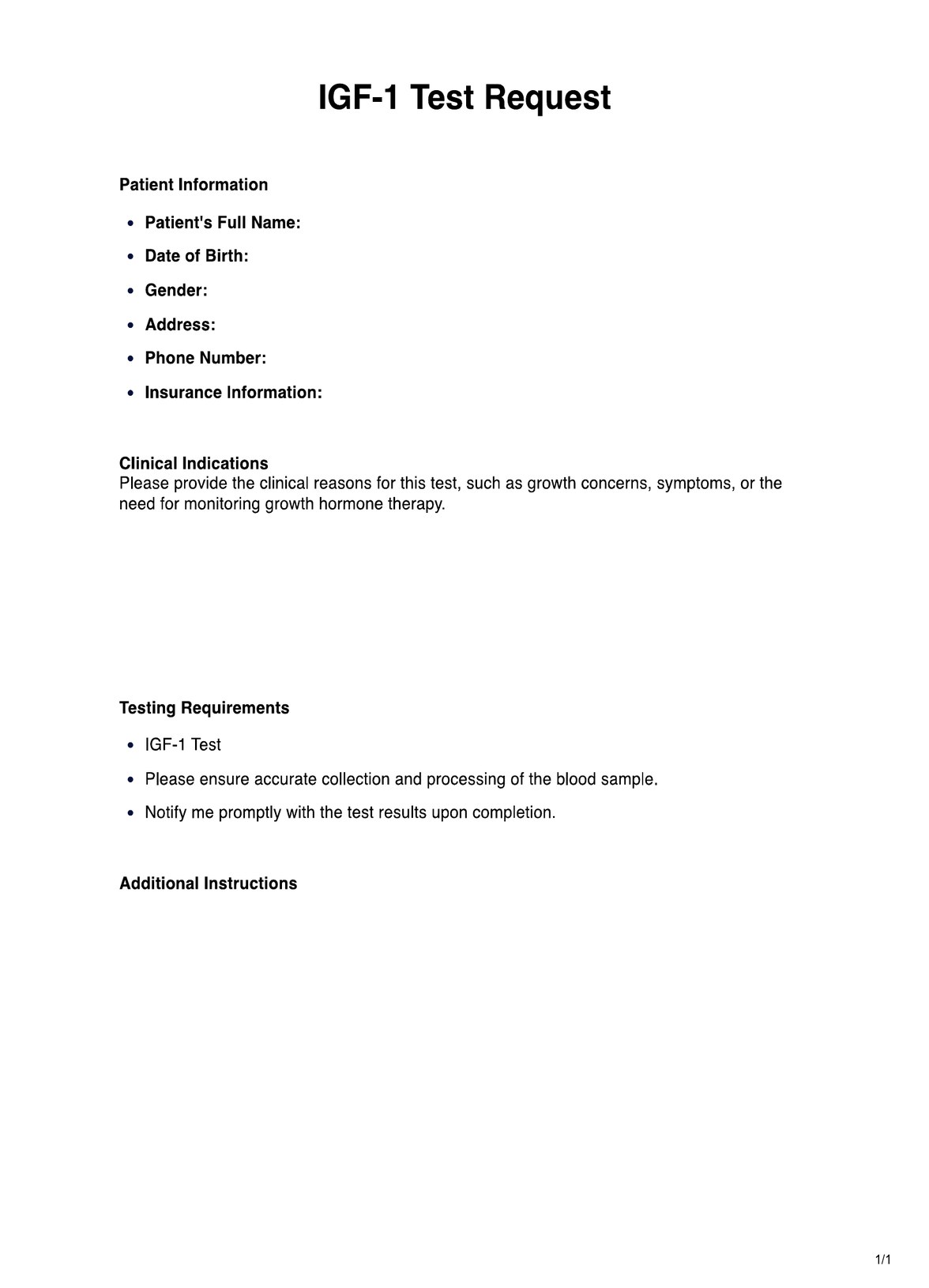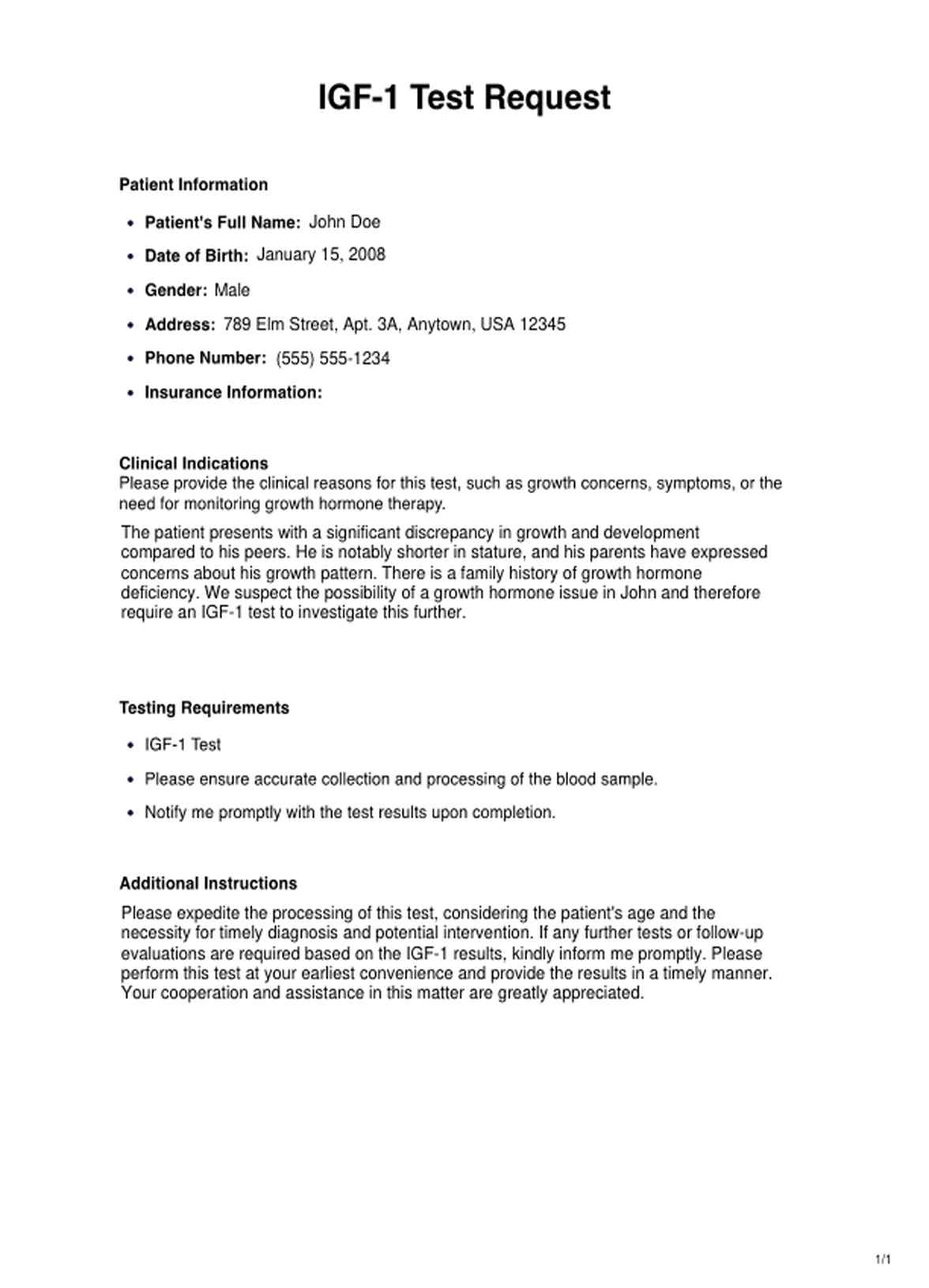IGF-1
Get accurate IGF-1 test results for growth assessment—streamlined, reliable testing. Your health is our priority.


What is an IGF-1 Test?
The IGF-1 test measures the level of a liver-produced hormone, Insulin-like Growth Factor-1, in the bloodstream. It's essential for childhood growth and has various adult functions. Primarily used in clinical settings, this test evaluates IGF-1 production in the body.
- Growth Assessment: In children, the IGF-1 test is frequently used to evaluate growth disorders. Low levels of IGF-1 can indicate growth hormone deficiency, while elevated levels may be linked to conditions like gigantism or acromegaly, which result from excess growth hormone production.
- Monitoring Growth Hormone Therapy: Individuals with growth hormone deficiencies or related conditions may undergo growth hormone therapy. The IGF-1 test helps doctors monitor the effectiveness of these treatments by measuring the IGF-1 levels in the bloodstream.
- Aging and Health: IGF-1 levels can provide insights into overall health in adults. Lower IGF-1 levels have been associated with aging, malnutrition, and certain chronic diseases, while higher levels can be linked to conditions like acromegaly, diabetes, or cancer.
- Research and Performance Enhancement: IGF-1 has gained attention in sports and bodybuilding due to its potential role in muscle growth and repair. Athletes have been known to abuse it for performance enhancement, making it a target for doping control efforts.
The IGF-1 test requires a blood draw and measures results in nanograms per milliliter (ng/mL). IGF-1 levels can vary during the day due to diet, exercise, and sleep. To ensure accuracy, the test is often conducted under specific conditions. Consultation with a medical professional is vital for interpreting results because individual differences and medical history are crucial in assessing IGF-1 levels' significance for one's health.
IGF-1 Template
IGF-1 Example
How does it work?
A printable IGF-1 test is a convenient way to assess your IGF-1 hormone levels from the comfort of your home. Here are the steps involved in using and filling out the form:
Access the Form
Begin by obtaining a printable IGF-1 test form. These forms are typically available from healthcare providers, diagnostic labs, or online at-home testing platforms.
Personal Information
Fill in your personal information, including your name, date of birth, and contact details. This information is crucial for accurate test results and communication.
Medical History
Provide any relevant medical history or information your healthcare provider or the testing service may require. This could include details about any existing health conditions or medications you're taking.
Payment and Consent
Many printable IGF-1 test forms will require payment information or insurance details. Ensure you understand the cost associated with the test and provide consent for the testing service to proceed.
Sample Collection
Follow the instructions on the form for collecting a blood sample. Depending on the test kit or form provided, this often involves a simple finger prick or venipuncture.
Sample Submission
Package the collected blood sample according to the form's guidelines. This may involve placing it in a provided container or mailing it to a specified laboratory for analysis.
Submission Method
Indicate on the form how and where you intend to submit the sample. Some tests may require sending the sample to a designated laboratory, while others may offer drop-off locations.
Processing and Reporting
Once the laboratory receives your sample, they will process it and provide your IGF-1 test results. The time it takes to receive results may vary, so check the form for an estimated timeframe.
Interpretation
After receiving your results, consult a medical professional to interpret the findings. They can help you understand the significance of your IGF-1 levels in the context of your overall health and well-being.
When would you use this test?
The IGF-1 test is used in various situations and contexts depending on the specific healthcare and personal needs. Here are key scenarios for when to use the IGF-1 test:
- Growth Evaluation in Children and Adolescents: When a child or adolescent's growth rate is a concern, such as when they are not growing as expected, pediatricians may use the IGF-1 test to assess their growth hormone levels and diagnose potential growth disorders.
- Monitoring Growth Hormone Therapy: For individuals receiving growth hormone therapy, the IGF-1 test monitors treatment progress and ensures that the therapy effectively increases their IGF-1 levels, which are essential for growth.
- Diagnosis and Management of Acromegaly and Gigantism: In adults, the IGF-1 test is employed when there is suspicion of acromegaly or gigantism, characterized by excess growth hormone production. It helps confirm the diagnosis and monitor treatment.
- General Health Assessment: Primary care physicians recommend the IGF-1 test as part of general health assessments, especially when patients present with unexplained weight loss, fatigue, or unusual physical changes, as it can indicate underlying health issues.
- Sports and Fitness Training: Athletic trainers and coaches may suggest the IGF-1 test to athletes and bodybuilders to evaluate the effectiveness of their training programs, nutrition, and recovery strategies for muscle development.
- Anti-Doping Measures: Anti-doping agencies employ the IGF-1 test to identify athletes using performance-enhancing substances, making it a critical tool to ensure fair competition in sports.
- Individual Health Concerns: Anyone concerned about their health, growth, aging, or general well-being can request an IGF-1 test through their healthcare provider, especially if they suspect underlying health issues.
- Chronic Disease Management: Healthcare professionals managing chronic diseases, such as diabetes or cancer, may use the IGF-1 test to assess how these conditions impact hormone levels and overall health.

What do the results mean?
IGF-1 test results offer crucial insights into an individual's growth hormone levels, which can vary based on age and other factors. Interpretation should always involve a healthcare professional. Here are key IGF-1 test results and their implications:
- Normal Range (Age-Adjusted): A result within the normal range indicates healthy growth and development for children and adolescents. In adults, it signals well-balanced growth hormone production.
- Low IGF-1 Levels: Low IGF-1 in children or adolescents may indicate growth hormone deficiency, affecting growth. It can relate to aging or conditions like malnutrition, pituitary disorders, or chronic liver disease in adults.
- High IGF-1 Levels: High IGF-1 in children or adolescents can indicate gigantism. In adults, it may suggest acromegaly, marked by enlarged bones and tissues, and could also be linked to pituitary gland tumors.
- Inconclusive Results: Test results may occasionally fall outside the typical normal or abnormal ranges, but they don't clearly indicate a specific condition. In such cases, further evaluation and additional tests may be necessary to determine the underlying cause.
- Variability Due to Age and Gender: It's essential to consider the age and gender of the individual being tested. IGF-1 levels naturally vary throughout life, and they tend to be higher in males than females during adolescence and adulthood. A pediatric endocrinologist or an endocrinologist can help contextualize these results.
- Treatment Monitoring: For those undergoing growth hormone therapy, the test is used to monitor the effectiveness of treatment. An increase in IGF-1 levels over time indicates a positive response to therapy, while stagnant or declining levels may necessitate adjustments in treatment.
- Research and Sports: In sports and research settings, results outside the typical range, significantly elevated IGF-1 levels, can raise concerns about the potential use of performance-enhancing substances, which is a focus of anti-doping efforts.
Research & Evidence
The Insulin-like Growth Factor-1 (IGF-1) test has a well-established history in endocrinology and growth-related research. It's closely linked to the understanding of growth hormone physiology.
The concept of growth-promoting hormones dates back to the early 20th century when researchers first identified the pituitary gland's role in controlling growth.
In the mid-20th century, advancements in hormone research led to the discovery of the growth hormone and its downstream effects on producing IGF-1 in the liver.
The IGF-1 test started to gain prominence as a clinical tool in the late 20th century, primarily for diagnosing and monitoring growth-related disorders in children. In the 1980s and 1990s, the understanding of IGF-1's role in growth and health expanded, leading to more applications in adult endocrinology, aging research, and sports medicine.
Numerous clinical studies and trials have proven the IGF-1 test's reliability and utility. These studies have highlighted the correlation between IGF-1 levels and various medical conditions.
For example, research has shown low IGF-1 levels can indicate growth hormone deficiency in children and adults. High IGF-1 levels are associated with acromegaly, gigantism, and certain tumors.
The IGF-1 test has played a pivotal role in assessing the effectiveness of growth hormone therapies, such as somatropin, in children and adults with growth hormone deficiencies.
In sports, research has examined the use of IGF-1 as a marker for potential doping in athletes. Elevated IGF-1 levels can be a red flag for using performance-enhancing substances.
The use of the IGF-1 test continues to evolve with ongoing research. New insights into its role in aging, metabolism, and chronic diseases contribute to its importance in modern healthcare.
References
- Medical Diagnosis. (2023, August 24). Medical diagnosis - Insulin-like growth factor (IGF-1). https://www.medical-diagnosis.co.uk/exam/all-tests/hormones/insulin-like-growth-factor-igf-1/
- Testing.com. (2021, November 9). Insulin-like growth factor-1 (IGF-1) - Testing.com. https://www.testing.com/tests/insulin-growth-factor-1-igf-1/
- Testmottagningen. (n.d.). IGF-1 – Test your levels of S-IGF1. https://www.testmottagningen.se/en/tester/hormoner/igf-1-test/
- Tseretopoulou, X., & Mushtaq, T. (2020). How to interpret IGF-1 and growth hormone stimulation tests. Archives of Disease in Childhood-education and Practice Edition. https://doi.org/10.1136/archdischild-2019-318466
Commonly asked questions
IGF-1 Tests are typically requested by healthcare professionals, including pediatricians, endocrinologists, primary care physicians, and individuals concerned about their health.
IGF-1 Tests are used to assess growth and hormone-related concerns in children and adults, monitor growth hormone therapy, evaluate overall health, and in sports to detect performance-enhancing substances.
The test involves a blood draw, which is processed in a laboratory. It can also be done with at-home test kits, collecting a blood sample and sending it to a lab for analysis.
The test, including the blood draw, typically takes only a few minutes. However, the processing of the sample and result delivery can take several days to a week, depending on the laboratory and method used.











































































































